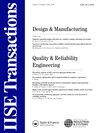Similarity-based Sampling for Simulation with Binary Outcomes
IF 2
3区 工程技术
Q3 ENGINEERING, INDUSTRIAL
引用次数: 0
Abstract
AbstractAbstract–We consider a feasibility determination problem via simulation with stochastic binary outcomes, in which the design space can be either discrete or continuous, and outcomes can be predicted through a functional relationship that depends on linear combinations of design variables. The goal is to identify all the feasible designs with means (i.e., probabilities) no smaller than a threshold. A logistic model is used to capture the relationship between the probability and design variables. Traditional binary rewards often conceal the numbers of correct and false determinations, thereby being inefficient in large and continuous design spaces. We thus propose a similarity measure to smooth binary rewards. Then, a sampling policy that optimizes a so-called similarity differential (SD) is developed. Under some mild conditions, we show that the SD policy is capable of identifying all the feasible designs as the sampling budget goes to infinity. Two approximate versions of the SD policy are developed to sequentially determine the sampling decisions in large and continuous design spaces. Extensive numerical experiments are conducted to demonstrate the superior performance of our SD policy, document computational savings, and reveal underlying sampling behaviors. Alternatively, we provide a simple but effective heuristic that can be easily used by practitioners.Keywords: simulationfeasibility determinationbinary outcomesoptimal computing budget allocationexperimental designDisclaimerAs a service to authors and researchers we are providing this version of an accepted manuscript (AM). Copyediting, typesetting, and review of the resulting proofs will be undertaken on this manuscript before final publication of the Version of Record (VoR). During production and pre-press, errors may be discovered which could affect the content, and all legal disclaimers that apply to the journal relate to these versions also. AcknowledgementsWe thank the editors and anonymous reviewers for valuable comments. This paper is supported by the National Science Foundation of China [Grant No. 72301187, 72122019, and 71771202], and by the Fundamental Research Funds for the Central Universities [Grant No. SXYPY202346]Additional informationNotes on contributorsHaitao LiuHaitao Liu received his Ph.D. degree in the Department of Industrial Systems Engineering and Management at National University of Singapore in 2022. He is currently an associate professor in Business School at Sichuan University. His research interests include simulation optimization, statistical learning, and supply chain management.Ping CaoPing Cao received his Ph.D. degree in Operational Research at Academy of Mathematics and Systems Science, Chinese Academy of Science in 2011. He is currently a professor at the School of Management in University of Science and Technology of China. He His research interests include stochastic control, queueing theory, Markov decision process, and dynamic pricing in revenue management.Loo Hay LeeLoo Hay Lee received his Ph.D. degree in Engineering Science from Harvard University, USA. He was a Professor in the Department of Industrial Systems Engineering and Management at National University of Singapore. His research interests include logistics, vehicle routing, supply chain modeling, and simulation-based optimization.Ek Peng ChewEk Peng Chew received his Ph.D. degree in Industrial Engineering from Georgia Institute of Technology, USA. He currently is a Professor in the Department of Industrial Systems Engineering and Management at National University of Singapore. His research areas are in port logistics, maritime transportation, and inventory management.基于相似性的二值结果模拟抽样
摘要:本文考虑了一个具有随机二元结果的模拟可行性确定问题,其中设计空间可以是离散的,也可以是连续的,并且结果可以通过依赖于设计变量的线性组合的函数关系来预测。目标是用不小于阈值的方法(即概率)识别所有可行的设计。逻辑模型用于捕获概率和设计变量之间的关系。传统的二元奖励通常会隐藏正确和错误决定的数量,因此在大型和连续的设计空间中效率低下。因此,我们提出了平滑二元奖励的相似性度量。然后,开发了一种优化所谓相似性差分(SD)的抽样策略。在一些温和的条件下,我们证明了当抽样预算趋于无穷时,SD策略能够识别出所有可行的设计。开发了两个近似版本的SD策略,以顺序确定大型连续设计空间中的采样决策。进行了大量的数值实验,以证明我们的SD策略的优越性能,记录计算节省,并揭示潜在的采样行为。另外,我们提供了一个简单但有效的启发式,可以很容易地被实践者使用。关键词:模拟可行性确定二元结果最优计算预算分配实验设计免责声明作为对作者和研究人员的服务,我们提供此版本的接受稿件(AM)。在最终出版版本记录(VoR)之前,将对该手稿进行编辑、排版和审查。在制作和印前,可能会发现可能影响内容的错误,所有适用于期刊的法律免责声明也与这些版本有关。感谢编辑和匿名审稿人的宝贵意见。国家自然科学基金[资助号:72301187,72122019,71771202];中央高校基本科研业务费专项基金[资助号:71771202];刘海涛于2022年毕业于新加坡国立大学工业系统工程与管理系,获博士学位。现任四川大学商学院副教授。他的研究兴趣包括仿真优化、统计学习和供应链管理。曹平,2011年获中国科学院数学与系统科学研究院运筹学博士学位。现任中国科学技术大学管理学院教授。主要研究方向为随机控制、排队理论、马尔可夫决策过程、收益管理中的动态定价等。Loo Hay Lee,获美国哈佛大学工程科学博士学位。他曾任新加坡国立大学工业系统工程与管理系教授。他的研究兴趣包括物流、车辆路线、供应链建模和基于仿真的优化。周泽鹏博士毕业于美国佐治亚理工学院工业工程专业。他目前是新加坡国立大学工业系统工程与管理系的教授。主要研究方向为港口物流、海运、库存管理。
本文章由计算机程序翻译,如有差异,请以英文原文为准。
求助全文
约1分钟内获得全文
求助全文
来源期刊

IISE Transactions
Engineering-Industrial and Manufacturing Engineering
CiteScore
5.70
自引率
7.70%
发文量
93
期刊介绍:
IISE Transactions is currently abstracted/indexed in the following services: CSA/ASCE Civil Engineering Abstracts; CSA-Computer & Information Systems Abstracts; CSA-Corrosion Abstracts; CSA-Electronics & Communications Abstracts; CSA-Engineered Materials Abstracts; CSA-Materials Research Database with METADEX; CSA-Mechanical & Transportation Engineering Abstracts; CSA-Solid State & Superconductivity Abstracts; INSPEC Information Services and Science Citation Index.
Institute of Industrial and Systems Engineers and our publisher Taylor & Francis make every effort to ensure the accuracy of all the information (the "Content") contained in our publications. However, Institute of Industrial and Systems Engineers and our publisher Taylor & Francis, our agents, and our licensors make no representations or warranties whatsoever as to the accuracy, completeness, or suitability for any purpose of the Content. Any opinions and views expressed in this publication are the opinions and views of the authors, and are not the views of or endorsed by Institute of Industrial and Systems Engineers and our publisher Taylor & Francis. The accuracy of the Content should not be relied upon and should be independently verified with primary sources of information. Institute of Industrial and Systems Engineers and our publisher Taylor & Francis shall not be liable for any losses, actions, claims, proceedings, demands, costs, expenses, damages, and other liabilities whatsoever or howsoever caused arising directly or indirectly in connection with, in relation to, or arising out of the use of the Content. Terms & Conditions of access and use can be found at http://www.tandfonline.com/page/terms-and-conditions .
 求助内容:
求助内容: 应助结果提醒方式:
应助结果提醒方式:


